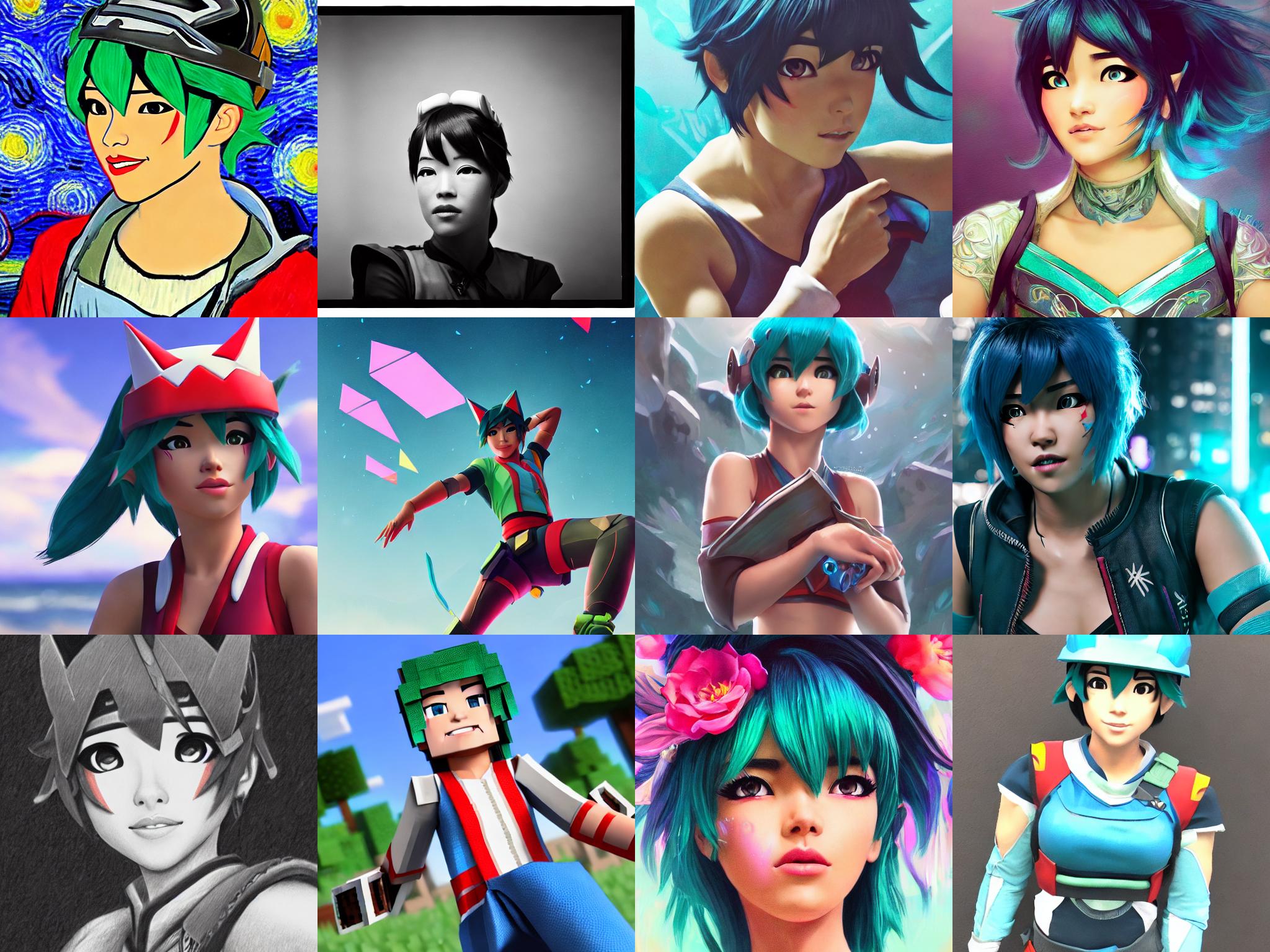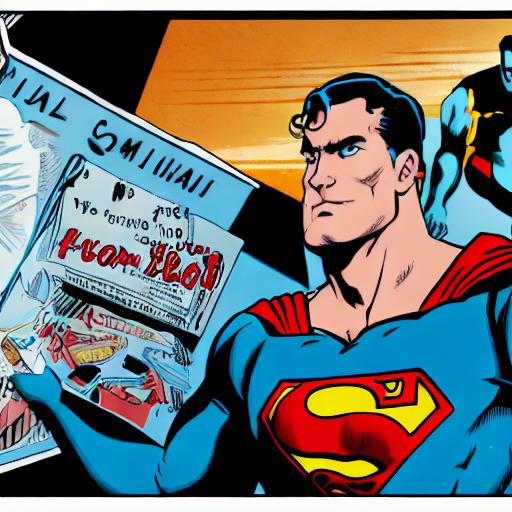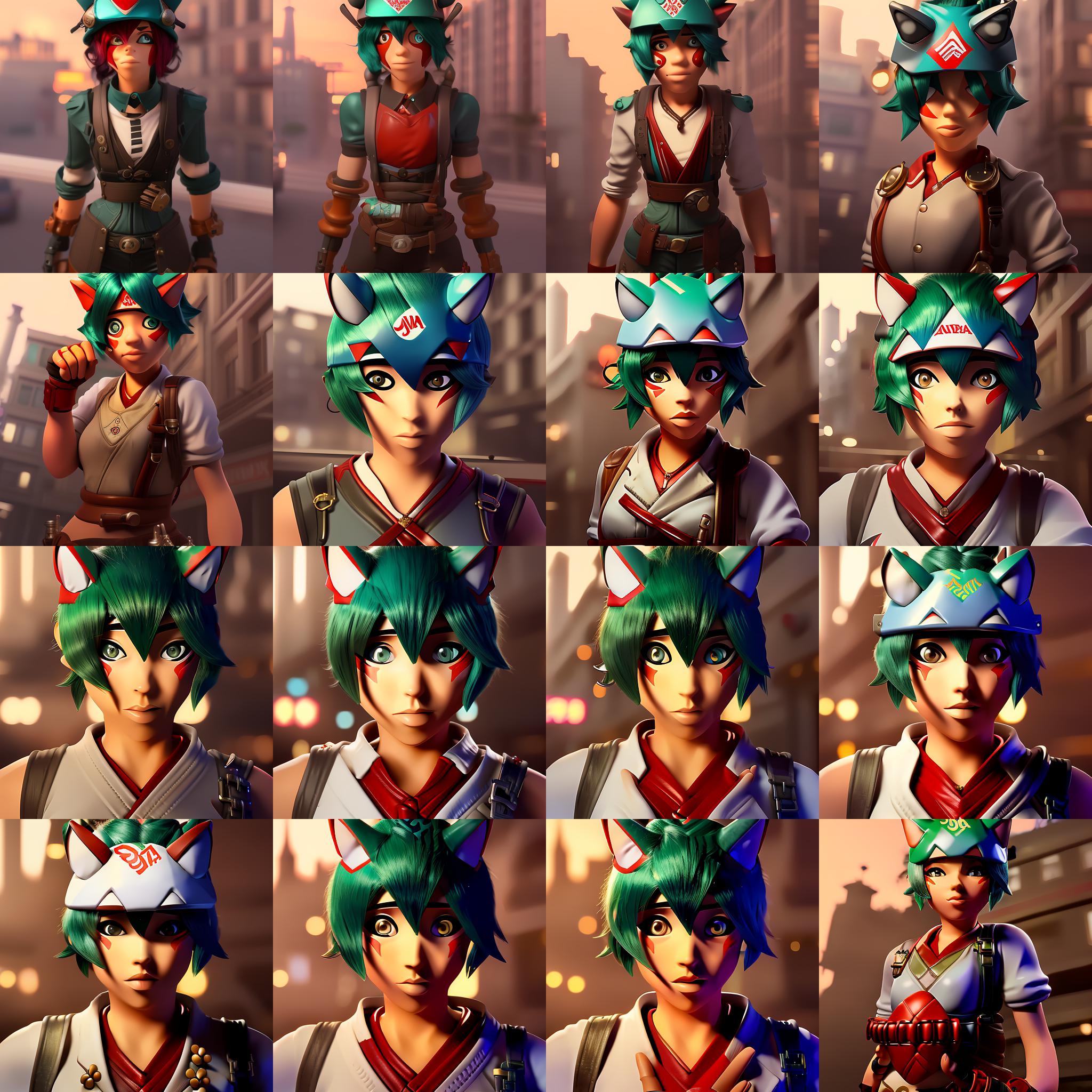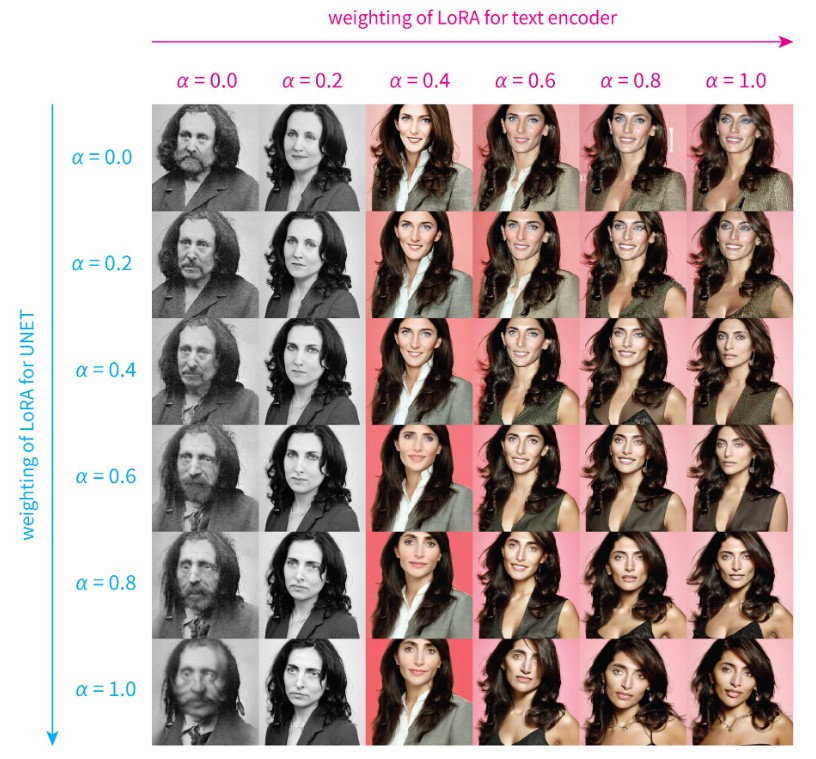Using LoRA to fine tune on illustration dataset :
$W = W_0 + \alpha \Delta W$ , where$\alpha$ is the merging ratio. Above gif is scaling alpha from 0 to 1. Setting alpha to 0 is same as using the original model, and setting alpha to 1 is same as using the fully fine-tuned model.
SD 1.5 PTI on Kiriko, the game character, Various Prompts.
"baby lion in style of <s1><s2>", with disney-style LoRA model.
"superman, style of <s1><s2>", with pop-art style LoRA model.
- Fine-tune Stable diffusion models twice as fast than dreambooth method, by Low-rank Adaptation
- Get insanely small end result (1MB ~ 6MB), easy to share and download.
- Compatible with
diffusers - Support for inpainting
- Sometimes even better performance than full fine-tuning (but left as future work for extensive comparisons)
- Merge checkpoints + Build recipes by merging LoRAs together
- Pipeline to fine-tune CLIP + Unet + token to gain better results.
- Out-of-the box multi-vector pivotal tuning inversion
-
Integrated into Huggingface Spaces 🤗 using Gradio. Try out the Web Demo
-
Easy colab running example of Dreambooth by @pedrogengo
- Support for training inpainting on LoRA PTI. Use flag
--train-inpaintingwith a inpainting stable diffusion base model (seeinpainting_example.sh).
- LoRA Joining is now available with
--mode=ljlflag. Only three parameters are required :path_to_lora1,path_to_lora2, andpath_to_save.
- Dataset pipelines
- LoRA Applied to Resnet as well, use
--use_extended_lorato use it. - SVD distillation now supports resnet-lora as well.
- Compvis format Conversion script now works with safetensors, and will for PTI it will return Textual inversion format as well, so you can use it in embeddings folder.
- 🥳🥳, LoRA is now officially integrated into the amazing Huggingface 🤗
diffuserslibrary! Check out the Blog and examples! (NOTE : It is CURRENTLY DIFFERENT FILE FORMAT)
- Pivotal Tuning Inversion with extended latent
- Better textual inversion with Norm prior
- Mask conditioned score estimation loss
- safetensor support, xformers support (thanks to @hafriedlander)
- Distill fully trained model to LoRA with SVD distillation CLI
- Flexiable dataset support
- Pivotal Tuning now available with
run_lorpt.sh - More Utilities added, such as datasets,
patch_pipefunction to patch CLIP, Unet, Token all at once. - Adjustable Ranks, Fine-tuning Feed-forward layers.
- More example notebooks added.
- You can now fine-tune text_encoder as well! Enabled with simple
--train_text_encoder - Converting to CKPT format for A1111's repo consumption! (Thanks to jachiam's conversion script)
- Img2Img Examples added.
- Please use large learning rate! Around 1e-4 worked well for me, but certainly not around 1e-6 which will not be able to learn anything.
Thanks to the generous work of Stability AI and Huggingface, so many people have enjoyed fine-tuning stable diffusion models to fit their needs and generate higher fidelity images. However, the fine-tuning process is very slow, and it is not easy to find a good balance between the number of steps and the quality of the results.
Also, the final results (fully fined-tuned model) is very large. Some people instead works with textual-inversion as an alternative for this. But clearly this is suboptimal: textual inversion only creates a small word-embedding, and the final image is not as good as a fully fine-tuned model.
Well, what's the alternative? In the domain of LLM, researchers have developed Efficient fine-tuning methods. LoRA, especially, tackles the very problem the community currently has: end users with Open-sourced stable-diffusion model want to try various other fine-tuned model that is created by the community, but the model is too large to download and use. LoRA instead attempts to fine-tune the "residual" of the model instead of the entire model: i.e., train the
Where we can further decompose
Also, not all of the parameters need tuning: they found that often,
Now, how would we actually use this to update diffusion model? First, we will use Stable-diffusion from stability-ai. Their model is nicely ported through Huggingface API, so this repo has built various fine-tuning methods around them. In detail, there are three subtle but important distictions in methods to make this work out.
First, there is LoRA applied to Dreambooth. The idea is to use prior-preservation class images to regularize the training process, and use low-occuring tokens. This will keep the model's generalization capability while keeping high fidelity. If you turn off prior preservation, and train text encoder embedding as well, it will become naive fine tuning.
Second, there is Textual inversion. There is no room to apply LoRA here, but it is worth mentioning. The idea is to instantiate new token, and learn the token embedding via gradient descent. This is a very powerful method, and it is worth trying out if your use case is not focused on fidelity but rather on inverting conceptual ideas.
Last method (although originally proposed for GANs) takes the best of both worlds to further benefit. When combined together, this can be implemented as a strict generalization of both methods. Simply you apply textual inversion to get a matching token embedding. Then, you use the token embedding + prior-preserving class image to fine-tune the model. This two-fold nature make this strict generalization of both methods.
Enough of the lengthy introduction, let's get to the code.
pip install git+https://github.com/cloneofsimo/lora.gitIf you have over 12 GB of memory, it is recommended to use Pivotal Tuning Inversion CLI provided with lora implementation. They have the best performance, and will be updated many times in the future as well. These are the parameters that worked for various dataset. ALL OF THE EXAMPLE ABOVE WERE TRAINED WITH BELOW PARAMETERS
export MODEL_NAME="runwayml/stable-diffusion-v1-5"
export INSTANCE_DIR="./data/data_disney"
export OUTPUT_DIR="./exps/output_dsn"
lora_pti \
--pretrained_model_name_or_path=$MODEL_NAME \
--instance_data_dir=$INSTANCE_DIR \
--output_dir=$OUTPUT_DIR \
--train_text_encoder \
--resolution=512 \
--train_batch_size=1 \
--gradient_accumulation_steps=4 \
--scale_lr \
--learning_rate_unet=1e-4 \
--learning_rate_text=1e-5 \
--learning_rate_ti=5e-4 \
--color_jitter \
--lr_scheduler="linear" \
--lr_warmup_steps=0 \
--placeholder_tokens="<s1>|<s2>" \
--use_template="style"\
--save_steps=100 \
--max_train_steps_ti=1000 \
--max_train_steps_tuning=1000 \
--perform_inversion=True \
--clip_ti_decay \
--weight_decay_ti=0.000 \
--weight_decay_lora=0.001\
--continue_inversion \
--continue_inversion_lr=1e-4 \
--device="cuda:0" \
--lora_rank=1 \
# --use_face_segmentation_condition\Check here to see what these parameters mean.
Basic usage is as follows: prepare sets of
from lora_diffusion import inject_trainable_lora, extract_lora_ups_down
...
unet = UNet2DConditionModel.from_pretrained(
pretrained_model_name_or_path,
subfolder="unet",
)
unet.requires_grad_(False)
unet_lora_params, train_names = inject_trainable_lora(unet) # This will
# turn off all of the gradients of unet, except for the trainable LoRA params.
optimizer = optim.Adam(
itertools.chain(*unet_lora_params, text_encoder.parameters()), lr=1e-4
)Another example of this, applied on Dreambooth can be found in training_scripts/train_lora_dreambooth.py. Run this example with
training_scripts/run_lora_db.shAnother dreambooth example, with text_encoder training on can be run with:
training_scripts/run_lora_db_w_text.shWe've seen that people have been merging different checkpoints with different ratios, and this seems to be very useful to the community. LoRA is extremely easy to merge.
By the nature of LoRA, one can interpolate between different fine-tuned models by adding different
Currently, LoRA cli has three options : merge full model with LoRA, merge LoRA with LoRA, or merge full model with LoRA and changes to ckpt format (original format)
SYNOPSIS
lora_add PATH_1 PATH_2 OUTPUT_PATH <flags>
POSITIONAL ARGUMENTS
PATH_1
Type: str
PATH_2
Type: str
OUTPUT_PATH
Type: str
FLAGS
--alpha
Type: float
Default: 0.5
--mode
Type: Literal['upl', 'lpl', 'upl', 'upl-ckpt-v2']
Default: 'lpl'
--with_text_lora
Type: bool
Default: False
$ lora_add PATH_TO_DIFFUSER_FORMAT_MODEL PATH_TO_LORA.safetensors OUTPUT_PATH ALPHA --mode uplpath_1 can be both local path or huggingface model name. When adding LoRA to unet, alpha is the constant as below:
So, set alpha to 1.0 to fully add LoRA. If the LoRA seems to have too much effect (i.e., overfitted), set alpha to lower value. If the LoRA seems to have too little effect, set alpha to higher than 1.0. You can tune these values to your needs. This value can be even slightly greater than 1.0!
Example
$ lora_add runwayml/stable-diffusion-v1-5 ./example_loras/lora_krk.safetensors ./output_merged 0.8 --mode uplEverything same as above, but with mode upl-ckpt-v2 instead of upl.
$ lora_add runwayml/stable-diffusion-v1-5 ./example_loras/lora_krk.safetensors ./output_merged.ckpt 0.7 --mode upl-ckpt-v2$ lora_add PATH_TO_LORA1.safetensors PATH_TO_LORA2.safetensors OUTPUT_PATH.safetensors ALPHA_1 ALPHA_2alpha is the ratio of the first model to the second model. i.e.,
Set
Example
$ lora_add ./example_loras/analog_svd_rank4.safetensors ./example_loras/lora_krk.safetensors ./krk_analog.safetensors 2.0 0.7Checkout scripts/run_inference.ipynb for an example of how to make inference with LoRA.
Checkout scripts/run_img2img.ipynb for an example of how to make inference with LoRA.
Checkout scripts/merge_lora_with_lora.ipynb for an example of how to merge Lora with Lora, and make inference dynamically using monkeypatch_add_lora.
Above results are from merging lora_illust.pt with lora_kiriko.pt with both 1.0 as weights and 0.5 as
and
I'm curating a list of tips and discussions here. Feel free to add your own tips and discussions with a PR!
- Discussion by @nitrosocke, can be found here
- Configurations by @xsteenbrugge, Using Clip-interrogator to get a decent prompt seems to work well for him, https://twitter.com/xsteenbrugge/status/1602799180698763264
- Super easy colab running example of Dreambooth by @pedrogengo
-
Amazing in-depth analysis on the effect of rank,
$\alpha_{unet}$ ,$\alpha_{clip}$ , and training configurations from brian6091!
Effect of fine tuning (both Unet + CLIP) can be seen in the following image, where each image is another 500 steps.
Trained with 9 images, with lr of 1e-4 for unet, and 5e-5 for CLIP. (You can adjust this with --learning_rate=1e-4 and --learning_rate_text=5e-5)
"female game character bnha, in a steampunk city, 4K render, trending on artstation, masterpiece". Visualization notebook can be found at scripts/lora_training_process_visualized.ipynb
You can see that with 2500 steps, you already get somewhat good results.
People using dreambooth are used to using lr around 1e-6, but this is way too small for training LoRAs. I've tried using 1e-4, and it is OK. I think these values should be more explored statistically.
Let's see: the following is only using Unet LoRA:
And the following is only using Text Encoder LoRA:
So they learnt different aspect of the dataset, but they are not mutually exclusive. You can use both of them to get better results, and tune them seperately to get even better results.
With LoRA Text Encoder, Unet, all the schedulers, guidance scale, negative prompt etc. etc., you have so much to play around with to get the best result you want. For example, with
Left with tuned
$\alpha_{unet} = 0.6$ ,$\alpha_{text} = 0.9$ , right with$\alpha_{unet} = 1.0$ ,$\alpha_{text} = 1.0$ .
Here is an extensive visualization on the effect of
"a photo of (S*)", trained with 21 images, with rank 16 LoRA. More details can be found here
TODOS
- Make this more user friendly for non-programmers
- Make a better documentation
- Kronecker product, like LoRA [https://arxiv.org/abs/2106.04647]
- Adaptor-guidance
- Time-aware fine-tuning.
This work was heavily influenced by, and originated from these awesome researches. I'm just applying them here.
@article{roich2022pivotal,
title={Pivotal tuning for latent-based editing of real images},
author={Roich, Daniel and Mokady, Ron and Bermano, Amit H and Cohen-Or, Daniel},
journal={ACM Transactions on Graphics (TOG)},
volume={42},
number={1},
pages={1--13},
year={2022},
publisher={ACM New York, NY}
}@article{ruiz2022dreambooth,
title={Dreambooth: Fine tuning text-to-image diffusion models for subject-driven generation},
author={Ruiz, Nataniel and Li, Yuanzhen and Jampani, Varun and Pritch, Yael and Rubinstein, Michael and Aberman, Kfir},
journal={arXiv preprint arXiv:2208.12242},
year={2022}
}@article{gal2022image,
title={An image is worth one word: Personalizing text-to-image generation using textual inversion},
author={Gal, Rinon and Alaluf, Yuval and Atzmon, Yuval and Patashnik, Or and Bermano, Amit H and Chechik, Gal and Cohen-Or, Daniel},
journal={arXiv preprint arXiv:2208.01618},
year={2022}
}@article{hu2021lora,
title={Lora: Low-rank adaptation of large language models},
author={Hu, Edward J and Shen, Yelong and Wallis, Phillip and Allen-Zhu, Zeyuan and Li, Yuanzhi and Wang, Shean and Wang, Lu and Chen, Weizhu},
journal={arXiv preprint arXiv:2106.09685},
year={2021}
}









